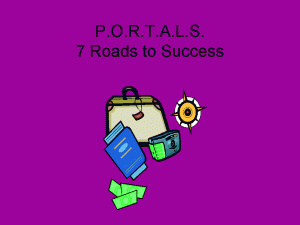This is the last in a series of learning framework that focuses more generally on how students learn, although each has some reference to the concept of self-management. Subsequent posts will look at two other types of teaching/learning frameworks: individualizing learning and personal qualities of learners, which focus more singularly and specifically on ideas related to “executive function”.
In this post I focus on what I understand to be the connections between the PORTALS framework and the Understanding by Design framework. The connections noted come from a publication that lists “The Big Ideas of Understanding by Design,” published in http://www.grantwiggins.org/documents/UbDQuikvue1005.pdf For additional details of their work, see the links below the chart.
 |
Understanding by Design by Grant Wiggins and Jay McTighe is a well- developed framework first published as a text in 1998 and revised in 2005.
In listing their Big Ideas of Understanding by Design, they list #1 as “UbD is a way of thinking purposefully about curriculum planning and school reform, a set of helpful design tools, and design standards—not a program or recipe.” (p. 14) I directly quote these Big Ideas below. |
| PURPOSE | 6 UbD transforms Content Standards and other goals into focused learning targets based on “big ideas” and transfer tasks. |
| OPERATIONS | 3 Evidence of understanding is revealed through performance—when learners transfer knowledge and skills effective—using one or more “facets” (explain, interpret, apply, shift perspectives, empathize, and self-assess). |
| REMEMBERING | 2 “…and the ability to transfer learning….” |
| TEAM WORK | 4 Educators are coaches of understanding, not mere purveyors of content and activity.
8 UbD reflects a “continuous improvement” approach to design and learning. The results of our curriculum designs (e.g., assessment results, quality of student work, degree of learner engagement) inform needed adjustments. |
| ACTION | 2 The end goals of UbD is understanding and the ability to transfer learning—to appropriately connect, make sense of, and use discrete knowledge and skills in context.
5 Planning is best done “backward” from the desired results and the transfer tasks that embody the goals. |
| LAYING A FOUNDATION | 2 “….to appropriately connect, make sense of, and use discrete knowledge (and skills) in context.” |
| SELF-MANAGEMENT | 7 Design Standards guide self-assessment and peer reviews of curriculum, instruction, and assessment for quality control. |
For additional information about the Understanding by Design framework, see the links below.
See McTighe’s ASCD article on the “confluence of evidence from two streams—theoretical research in cognitive psychology, and results of student achievement studies.” Found at
For a detailed description of this UbD work see:
http://www.ascd.org/ASCD/pdf/siteASCD/publications/UbD_WhitePaper0312.pdf
Source: Adapted from Wiggins, G., & McTighe, J. (2011). The Understanding by Design guide to creating high-quality units. Alexandria, VA: ASCD
Or see comments on the 2nd Edition:
http://www.ascd.org/Publications/Books/Overview/Understanding-by-Design-Expanded-2nd-Edition.aspx
About This Book
”What is understanding and how does it differ from knowledge? How can we determine the big ideas worth understanding? Why is understanding an important teaching goal, and how do we know when students have attained it? How can we create a rigorous and engaging curriculum that focuses on understanding and leads to improved student performance in today’s high-stakes, standards-based environment?
Authors Grant Wiggins and Jay McTighe answer these and many other questions in this second edition of Understanding by Design. Drawing on feedback from thousands of educators around the world who have used the UbD framework since its introduction in 1998, the authors have greatly revised and expanded their original work to guide educators across the K–16 spectrum in the design of curriculum, assessment, and instruction…. “
Leave a Reply